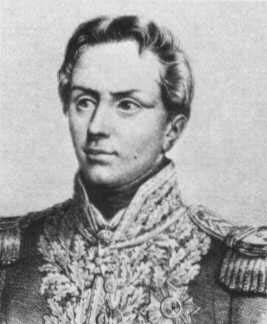General Alexandre Antoine Hureau de Senarmont

Born: April 21, 1769
Place of Birth: Strasbourg, Bas-Rhin, France
Died: October 26, 1810
Cause of Death: Killed in action
Place of Death: Cadiz, Spain
Arc de Triomphe: SENARMONT on the west pillar
Pronunciation:
The son of a French artillery officer, Alexandre Antoine Hureau de Senarmont began his military career by entering the artillery school of Metz in 1784. A year later he left the school as a lieutenant to serve in the 2nd Regiment of Artillery of Besançon. As the French Revolution got underway, in 1791 Senarmont served with the 7th Horse Artillery and then throughout 1792 and 1793 he served in the Army of the Center and the Army of the North. Promoted to capitaine in August of 1792, he became an aide-de-camp to his father and he served at the siege of Antwerp. In 1794 Senarmont joined the Army of the Sambre and Meuse and while serving under Desjardin he commanded the crew that built the bridge over the Sambre in June. Promoted to chef de bataillon in October of that year, Senarmont was then appointed the deputy director of artillery at Douai. After serving in Germany in 1797, he served with the Army of the Rhine in 1799. In 1800 he became chief of staff of artillery under Marmont in the Army of the Reserve and he was one of the key officers in getting the artillery over the passes of the Alps and past the troublesome Fort Bard. At Marengo he distinguished himself in battle and he was promoted to chef de brigade a few months later.
The next year Senarmont went to Douai as director of artillery there and in 1802 he took command of the 6th Foot Artillery in garrison at Rennes. In 1803 he was appointed the chief of staff of artillery at the camp of Brest and in 1805 he became deputy chief of staff of the artillery of the Grande Armée, serving under Songis. Senarmont served with the Grande Armée on the campaign of 1805 and he fought at Austerlitz in December. In July of 1806 he was promoted to général de brigade and the next month he became commander of his alma mater, the artillery school at Metz. His tenure there was short lived however, as by November he was back on campaign as the commander of the artillery of Marshal Augereau's VII Corps, replacing General Dorsner. In late February of 1807 Senarmont took command of the artillery of I Corps.
During the summer campaign of 1807, Senarmont distinguished himself at the Battle of Friedland where he signaled the charge and led his men in a series of successive bounds to within 120 yards of the Russian line. Rolling to a stop, his artillery opened fire on the Russian line at this near point blank range for artillery, while the French infantry and cavalry attempted to keep any Russian counterattacks away from them. Napoleon grew concerned and sent Mouton to find out what was going on, but when asked Senarmont responded, "Leave me and my gunners alone, I'll answer for everything."1 Due to this daring action, about half of his men became casualties, but he inflicted thousands of casualties upon the Russians. Never before had artillery charged and fired at such close ranges, but this action was so devastating that other officers used this new tactic in future battles.2
After Friedland Senarmont took a well earned leave and then in 1808 he once again took command of the artillery of Victor's I Corps. 1808 continued to be a busy year for Senarmont as he received the honors of being made a Baron of the Empire and a Knight of the Iron Crown, he distinguished himself at Somosierra , and he was promoted to général de division. He took charge of the artillery of the Army of Spain from Lariboisière in early 1809 and he served at the Battle of Ocaña . In 1810 he commanded the artillery at the siege of Cadiz where he was killed.
Notes
- F. G. Hourtoulle, From Eylau To Friedland, trans. Alan McKay, (Paris: Histoire & Collections, 2007), 88.
- John R. Elting, Swords Around a Throne: Napoleon's Grande Armée, (USA: Da Capo Press, 1997), 262.
Bibliography
- Haythornthwaite, Philip J. Who Was Who in the Napoleonic Wars. London: Arms & Armour, 1998.
- Six, Georges. Dictionnaire Biographique des Généraux & Amiraux Français de la Révolution et de l'Empire (1792-1814). 2 vols. Paris: Gaston Saffroy, 2003.
Updated March 2023
© Nathan D. Jensen